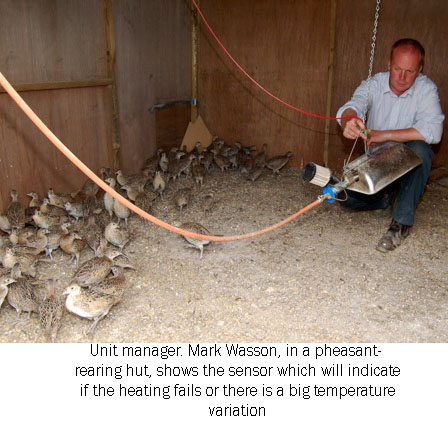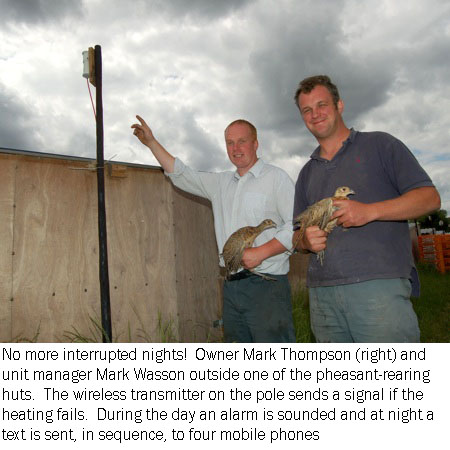
A wireless alarm system is saving money, improving bird welfare and giving peace of mind to the staff managing a pheasant-rearing enterprise in Kent.
The pheasants are reared from Aaday old to seven weeks by Dan Mackelden Ltd at Lested Farm, Chart Sutton, near Maidstone, for shoots in the south of England. The pheasants are kept in groups of 800 in plywood huts heated with gas-fired brooders, and outdoor runs.
Keeping the temperature stable is critical, says farm manager Mark Wasson. If one of the gas cylinders runs out the chicks tend to ’heap up’ to keep warm and smothering can occur leading to a high mortality rate — even as much as 50 per cent. This meant that each hut had to be individually checked every two hours throughout the night, a costly job in terms of labour. With pheasants worth up to £3 each serious losses could be disastrous.
On the recommendation of a pig farmer who used a heat-monitoring system, specialist farm energy control company, Farmex, from Reading, was called in to advise on installing a remotely controlled alarm system to give an early warning of sudden variations in temperature.

Farmex has developed systems for early warnings of ventilation failures in piggeries and potato stores and, following research, has recently started producing wireless systems to overcome the problem of isolated farm buildings. This proved to be ideal for the pheasant pens.
A battery-powered sensor was installed in each hut immediately above the heater. It transmits its readings to a wireless repeater, which then transmits it to a mains-powered Dicam alarm unit, also with battery back-up. This automatically texts mobile phones or sounds a siren if the temperature rises or falls beyond pre-set parameters.
The unit texts four phones in sequence. If there is no response from the first then it will move on to the rest in turn to be sure that someone will be alerted. Phones are therefore kept by the bedsides of staff at night while the pheasants are being reared, but the system is monitored 24 hours a day.
"We set the sensors directly above the heater emitters rather than elsewhere in the huts so that we would be alerted the moment there is any failure," commented Mark Wasson. This means a set temperature of 70ºC, which equates to 30ºC in the hut. "This gives us a little time to get down to the unit whereas if we were measuring ambient temperature inside the hut, the heater could be off some time before we were notified with a possibility of the pheasant chicks getting chilled before it could be rectified."
Total cost of the system was £2,600, which Mark reckons will pay for itself very quickly. A wire-up system was initially considered but this was deemed impractical because of roadways and the cost of installation. In addition, the huts and runs are moved to a new site each year for disease control. Initially, 13 sensors were installed but following more orders another four huts were commissioned and this involved only an extra £85 per hut for additional sensors.
There were some teething problems with weak signals, but signal boosters solved this. In fact, through Barn Report, a Farmex software program, a record of temperature in each hut over the entire rearing period can now be viewed.
www.farmex.com
